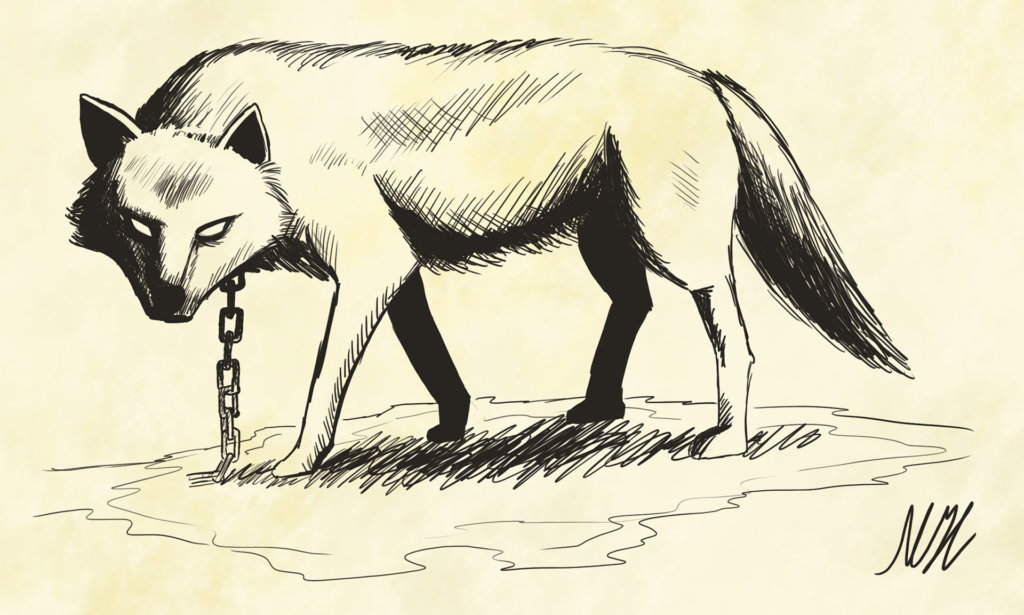Fenrisulven / Hróðvitnir / Vánagandr
Fenrir is a pivotal figure in Norse mythology, often described as a monstrous wolf. He is one of the most fearsome and significant creatures in the mythology, and his story is deeply intertwined with the gods and the events of Ragnarök, the prophesied end of the world.


Origins and Family
- Parentage:
- Fenrir is the son of the trickster god Loki and the giantess Angrboða. He is one of three children born from this union, with his siblings being Jörmungandr (the Midgard Serpent) and Hel (the ruler of the underworld). All three offspring are regarded as dangerous and were feared by the gods due to their potential roles in causing chaos and destruction.
- The Prophecy:
- The Aesir gods (the principal gods of Norse mythology) were aware of a prophecy that foretold the great harm Fenrir would cause them, particularly at Ragnarök. Fearing his strength and the potential danger he posed, the gods took measures to control and bind Fenrir before he could unleash his wrath.
Fenrir’s Early Life and Binding
- Raising Fenrir:
- The gods initially tried to raise Fenrir in Asgard, hoping to keep him under control. However, he grew at an alarming rate and soon became too large and powerful to handle. Only Týr, the god of war and justice, was brave enough to feed him.
- Attempts to Bind Him:
- As Fenrir continued to grow, the gods decided that they needed to bind him. They first attempted to use chains, but Fenrir broke them with ease. Finally, the gods sought the help of the dwarves, who crafted a magical ribbon called Gleipnir. Unlike the chains, Gleipnir appeared to be light and delicate but was imbued with incredible strength.
- The Trick:
- Knowing that Fenrir would not willingly allow himself to be bound, the gods tricked him. They told him that the binding was merely a test of his strength, and Fenrir, suspicious of their intentions, demanded that one of the gods place a hand in his mouth as a gesture of good faith. Týr bravely offered his hand, and when Fenrir realized he had been tricked and could not break free from Gleipnir, he bit off Týr’s hand in anger.
- Imprisonment:
- Once bound, Fenrir was left chained on a distant island, with a sword placed in his mouth to keep it open and prevent him from biting. He remained in this state, waiting for the day of Ragnarök when he would break free.
Fenrir’s Role in Ragnarök
- The Break of Gleipnir:
- During Ragnarök, the prophecy foretells that Fenrir will finally break free from Gleipnir and join the forces of chaos against the gods. He will rampage across the earth, devouring everything in his path.
- Battle with Odin:
- One of the most significant moments of Ragnarök is Fenrir’s battle with Odin, the Allfather and king of the Aesir gods. It is prophesied that Fenrir will devour Odin, ending the god’s reign and marking a major turning point in the battle.
- Odin’s son, Víðarr, is destined to avenge his father’s death. According to the prophecy, Víðarr will kill Fenrir by tearing open the wolf’s jaws, ending his reign of terror.
Symbolism of Fenrir
- Chaos and Destruction:
- Fenrir symbolizes the inevitable destruction that the gods fear but cannot avoid. His immense power, uncontrollable nature, and role in the death of Odin make him a personification of chaos and doom.
- Like other beings associated with Ragnarök, such as Jörmungandr and Surtr, Fenrir’s role represents the cyclical nature of destruction and renewal in Norse mythology. While he brings about the end of the world as it is known, his actions pave the way for the rebirth of the cosmos after Ragnarök.
- Betrayal and Vengeance:
- Fenrir’s story is also one of betrayal and vengeance. The gods, in their fear of his power, betray his trust by tricking and binding him. Fenrir’s vengeance is ultimately realized at Ragnarök, where he fulfills the prophecy by destroying Odin, the god who symbolized order and authority.
- Fate and Destiny:
- Fenrir’s tale highlights the Norse concept of fate (wyrd), where even the gods cannot escape their destined outcomes. Despite their attempts to control or avert the prophecy, the gods’ efforts only delay the inevitable, reinforcing the idea that fate is inescapable in Norse belief.
Modern Depictions
- Popular Culture:
- Fenrir has become a popular figure in modern media, often appearing in video games, films, books, and art that draw on Norse mythology. His image as a powerful, fearsome wolf has made him an iconic representation of wild, untamable forces of nature.
- In literature, Fenrir’s character has inspired both direct representations, such as in Rick Riordan’s Magnus Chase series, and more symbolic references in works about wolves or chaos-bringing figures.
- Fantasy and Mythology:
- Fenrir’s influence extends into fantasy literature and role-playing games, where the trope of the giant, world-ending wolf is a common element. His presence has shaped how wolves and other predatory creatures are depicted in modern mythological and fantasy settings.
Conclusion
Fenrir is a central figure in Norse mythology, representing the forces of chaos, destruction, and inevitability. As the son of Loki and a key player in Ragnarök, Fenrir’s role is both tragic and fearsome. Despite being feared and bound by the gods, his ultimate destiny is to break free and play a significant role in the destruction of the cosmos, paving the way for renewal. His story of betrayal, vengeance, and the inescapability of fate remains one of the most compelling narratives in Norse myth.
Description

Fenrir (ᚠᛖᚾᚱᛁᚱ) is a giant wolf from Norse mythology who together with the world serpent Jörmungandr and Hel, is a child of Loki and the giantess Angrboða.
When Loki brought the young wolf to the gods it was still small but it quickly grew in size and Odin had a rope (often depicted as a chain) forged by dwarves. The chain known as Gleipnir was made out of everything that cannot be seen or heard. It is thin like silk but stronger than all other materials.
The gods feared it too much to feed it. The only one brave enough was Tyr who had the mission befall him. One day when feeding the beast it took his hand in the process.
Later Fates of Fenrir
Fenrir as well as Loki are fettered on the island Lyngve in the ocean Amsvartner in Hel. By the ocean Amsvartner lies the beach Narstrand which is covered in huge deadly thorns. In some depictions the Narstrand is said to be used as a protection of the fettered wolf.
Fenrir plays a huge part of Ragnarök as he is fated to slay the allfather Odin and subsequently be slain by Odin’s son Víðarr. Fenrir’s two children Hati and Sköll also play a big part in the Destruction mythos as Hati is to consume the moon and Sköll is to consume the sun.
Sometimes Fenrir is said to have a third son named Garmr which would guard the gates of Hel like that of Cerberus. Most often Garmr and Fenrir is assumed to be one and the same as the both are said to be the one fated to battle Odin at the later half of Ragnarök.
Author

Josh Morley holds a Bachelor’s degree in Theology from the Trinity School of Theology and a Diploma in Theology from the Bible College of Wales. His academic journey involved interfaith community projects and supporting international students, experiences that shaped his leadership and reflective skills. Now based in Liverpool, Josh is also the founder of Marketing the Change, a digital agency specializing in web design and marketing.
View all posts




